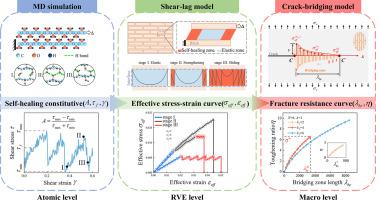生物启发交错异质结构中的界面自愈合增韧过程
IF 7.1
1区 工程技术
Q1 ENGINEERING, MECHANICAL
International Journal of Mechanical Sciences
Pub Date : 2024-11-20
DOI:10.1016/j.ijmecsci.2024.109847
引用次数: 0
摘要
在生物和生物启发异质结构的滑动界面中,牺牲键的动态断裂和重塑可提供一个自愈合的能量耗散过程,从而大大提高抗断裂性。然而,界面自愈合行为和非均匀应力传递如何在多个长度尺度上协同作用并提高断裂韧性仍是一个未知数。在此,我们通过整合界面自愈合行为、RVE 变形响应和宏观裂缝桥接,为生物启发交错异质结构建立了一个多尺度断裂力学模型。我们发现了两个临界砖尺寸,在这两个尺寸之间,界面自愈合过程增强的断裂韧性超过了理想弹塑性界面的断裂韧性。在这两个临界尺寸之间,由界面非均匀变形模式(包括弹性、强化和滑动阶段)引起的裂缝桥接应力和开口位移同时增加,从而提高了断裂韧性。此外,我们的模型还为优化具有自愈合界面的生物启发抗断裂结构材料提供了参数指导。本文章由计算机程序翻译,如有差异,请以英文原文为准。

Toughening by interfacial self-healing processes in bioinspired staggered heterostructures
Dynamic breaking and reforming of sacrificial bonds in sliding interfaces of biological and bioinspired heterostructures could greatly enhance fracture resistance by providing a self-healing energy dissipation process. Nevertheless, how interfacial self-healing behaviors and nonuniform stress transfer act in concert over multiple length scales and boost fracture toughness remains elusive. Here, a multiscale fracture mechanics model for bioinspired staggered heterostructures was developed by integrating interfacial self-healing behaviors, RVE's deformation responses, and macroscopic crack bridging. We found two critical brick sizes between which the fracture toughness enhanced by interfacial self-healing processes surpasses that by ideal elastic-plastic interface. The simultaneous increased crack-bridging stress and opening displacement induced by interfacial nonuniform deformation modes, including elastic, strengthening and sliding stages between the two critical sizes, are identified to enhance the fracture resistance. Moreover, our model provides parametric guidelines for optimizing bioinspired fracture-resistant structural materials with self-healing interfaces.
求助全文
通过发布文献求助,成功后即可免费获取论文全文。
去求助
来源期刊

International Journal of Mechanical Sciences
工程技术-工程:机械
CiteScore
12.80
自引率
17.80%
发文量
769
审稿时长
19 days
期刊介绍:
The International Journal of Mechanical Sciences (IJMS) serves as a global platform for the publication and dissemination of original research that contributes to a deeper scientific understanding of the fundamental disciplines within mechanical, civil, and material engineering.
The primary focus of IJMS is to showcase innovative and ground-breaking work that utilizes analytical and computational modeling techniques, such as Finite Element Method (FEM), Boundary Element Method (BEM), and mesh-free methods, among others. These modeling methods are applied to diverse fields including rigid-body mechanics (e.g., dynamics, vibration, stability), structural mechanics, metal forming, advanced materials (e.g., metals, composites, cellular, smart) behavior and applications, impact mechanics, strain localization, and other nonlinear effects (e.g., large deflections, plasticity, fracture).
Additionally, IJMS covers the realms of fluid mechanics (both external and internal flows), tribology, thermodynamics, and materials processing. These subjects collectively form the core of the journal's content.
In summary, IJMS provides a prestigious platform for researchers to present their original contributions, shedding light on analytical and computational modeling methods in various areas of mechanical engineering, as well as exploring the behavior and application of advanced materials, fluid mechanics, thermodynamics, and materials processing.
 求助内容:
求助内容: 应助结果提醒方式:
应助结果提醒方式:


